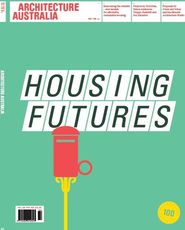Australian architects can design great houses – we all know that – but what does the profession have to offer beyond the realm of the bespoke house? What mechanisms might enable us to contribute more effectively to the provision of housing for a larger section of the population? What lessons, ideas and strategies can we extract from the history of our own discipline in this regard? How do we communicate the value of design in a market that is finely attuned to other factors? What role can government and private developers play in demonstrating possibilities and expanding the expectations of the community? How might housing be part of a broader engagement with the complex issues facing our urban and suburban environments? How might we renovate the suburbs? And what of “home”? How is the way we live changing? How might new and developing modes of domesticity affect the design of housing?
These are complex, pressing and intertwined questions. This issue of Architecture Australia (May/June 2011) explores such questions and related issues through essay, anecdote, proposal and the review of completed projects. It reveals a wide commitment within architecture and related disciplines to thinking through the issues and to offering both propositions and concrete built examples of how we might proceed. But these pages can accommodate only a small selection of the many initiatives and projects out there – we have aimed to provide a cross-section of what is becoming a significant field of endeavour. The last time the magazine devoted an issue to this topic was in May/June 2007. In the editorial for that issue I argued that to be effectively involved in housing “architecture, as a discipline, needs to stop fetishizing ‘the house’ and to start exploring housing in all its cultural and social complexity”. As the pages of this issue indicate, the exploration of these complexities has revived substantially over the last few years, as many in the architectural community pursue housing in different ways.
This time we have focused on projects, proposals and issues outside the inner-urban environments of our major cities. Leaving aside the inner city for the moment, we find a large array of different environments “out there” in the suburbs, and many ways of thinking about how housing models might help improve the qualities and viability of these quotidian urban environments. This seems much more productive than perpetuating the ubiquitous opposition between city and suburb, and the judgment that so often goes with it. Most Australians live in suburban environments of one kind or another. Simply despairing of them doesn’t get us very far; engaging thoughtfully and strategically with them might.
Justine Clark was the commissioning editor for Architecture Australia (May/June 2011).















